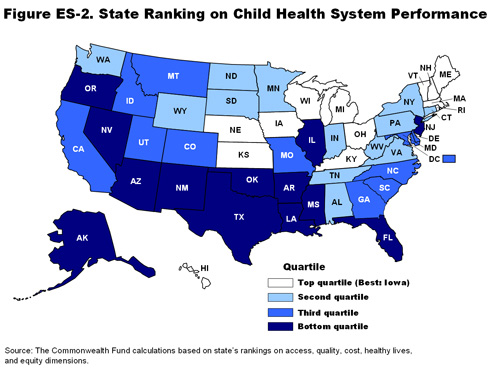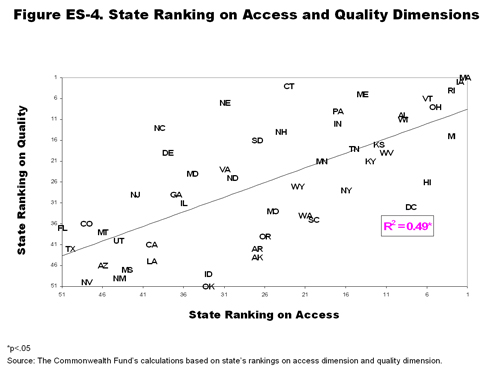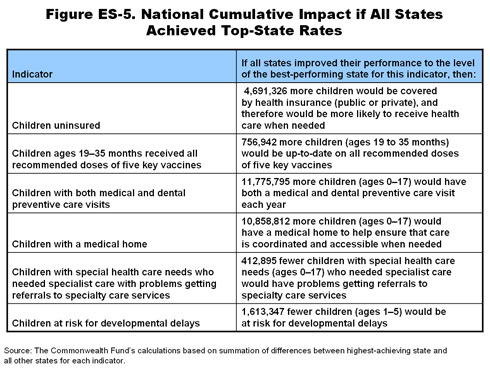Investing in child health is a high priority for state officials. More than one-third of children nationally receive health care funded by the federal government as well as the 50 states and the District of Columbia. Twenty-eight million children are covered by Medicaid, and 6 million are covered by the State Children's Health Insurance Program (SCHIP), which was enacted in 1997 to expand coverage of children in low-income families. Yet, some states do better than others in promoting the health and development of their youngest residents, and in ensuring that all children are on course to lead healthy and productive lives.
The recent State Scorecard on Health System Performance, prepared for The Commonwealth Fund Commission on a High Performance Health System, found that access to health care, as well as health care quality, costs, outcomes, and equity, vary widely across the states. This report examines performance variations among states' child health systems, building on many of the State Scorecard indicators as well as other key indicators of children's health. It finds similar variation in performance among states and abundant opportunities for all states to improve. With a goal of focusing on opportunities to improve, this analysis assesses performance relative to what is achievable, based on benchmarks drawn from the range of state health system performance.
The analysis focuses on 13 indicators of child health system performance along the dimensions of access, quality, costs, and the "potential to lead healthy lives." In addition, for two indicators, gaps in performance by income, race/ethnicity, and insurance are used to gauge equity. Six of the 13 indicators were included in the previously published State Scorecard; others were added from government data sources. All 50 states, plus the District of Columbia, are ranked on each indicator and the five dimensions of performance access, quality, costs, equity, and potential to lead healthy lives using the same methodology employed in the State Scorecard. The rankings for each dimension are then summed to derive an overall ranking for child health system performance. Figure ES-1 shows the indicators included, the range in variation across states, and the highest-achieving state on each indicator. (See "Appendix: Study Methodology" for further details.)
Highlights
Variations in state child health system performance point to six important findings:
- High performance is possible. Iowa and Vermont have created children's health care systems that are accessible, equitable, and deliver high-quality care, all while controlling levels of spending and family health insurance premiums. Over the last decade, both states adopted policies to expand children's access to care and improve their quality of care. In particular, Iowa and Vermont expanded SCHIP and mandated that all child health plans and local and regional children's health systems publicly report data on the quality of care. This analysis indicates that such policies make a difference.
-
Leading states consistently outperform lagging states on multiple child health indicators and dimensions. Thirteen states Iowa, Vermont, Maine, Massachusetts, Ohio, Hawaii, New Hampshire, Rhode Island, Kentucky, Kansas, Wisconsin, Michigan, and Nebraska emerge at the top quartile of the overall performance rankings. These states generally rank high on multiple indicators along each of the five dimensions assessed (Figure ES-2). Many have among the nation's lowest uninsured rates for children. Conversely, the 13 states at the bottom quartile of the overall performance ranking Illinois, New Mexico, New Jersey, Alaska, Oregon, Arkansas, Nevada, Texas, Arizona, Louisiana, Mississippi, Florida, and Oklahoma lag well behind their peers on multiple indicators across dimensions.

Uninsured rates for children in these states are well above national averages, and more than double those in the quartile of states with the lowest rates. Rates for receipt of recommended preventive care are generally low in these states, while rates of infant mortality and risk of developmental delay are often high. - There is wide variation in children's access to care and health care quality across the United States. The proportion of children who are uninsured ranges from 5 percent in Michigan to 20 percent in Texas. The proportion of children who have regular medical and dental preventive care ranges from 75 percent in Massachusetts to 46 percent in Idaho. The proportion of children hospitalized for asthma ranges from 55 per 100,000 children in Vermont to 314 per 100,000 in South Carolina (among the 33 states reporting this indicator).
- Children's access to medical homes primary care providers who deliver health care services that are easily accessible, family-centered, continuous, comprehensive, coordinated, and culturally competent varies widely across states. Sixty-one percent of children in New Hampshire, and over half of all children in all the New England states, have a medical home, compared with only one-third in Mississippi. Research shows that medical homes are an effective way to improve health care quality and reduce disparities by race, insurance status, and income. In this report, having a medical home is defined as having at least one preventive medical care visit in the past year; being able to access needed specialist care and services; and having a personal doctor/nurse who usually/always spends enough time and communicates clearly, provides telephone advice and urgent care when needed, and follows up after specialist care.
- Across states, better access to care is closely associated with better quality of care. Seven states Massachusetts, Iowa, Rhode Island, Ohio, Vermont, Alabama, and Wisconsin are national leaders in giving children access to care and ensuring high-quality care (Figure ES-4).
- There are strong regional patterns in child health system performance. New England and the North-Central states perform well on indicators of health care access, quality, and equity, while many western and southern states have lower health care costs. New England, Upper Midwest, East North-Central, and West North-Central states perform well on indicators measuring the potential for children to lead healthy lives. Yet, within any region, there are exceptions. Alabama is in the top quartile of states in terms of both access and quality. Texas and New Mexico perform well on child health outcomes, while Kentucky and West Virginia perform well on measures of health system equity. Learning more about such exceptions to regional patterns may provide insights into effective policies to support children's health. For example, Alabama was an early implementer of SCHIP and provides additional coverage through Alabama Blue Cross Blue Shield for children in families with income just above SCHIP's eligibility threshold.

Benchmarks set by leading states show there are opportunities to improve health system performance to benefit children. If all states achieved top levels on each dimension of performance, 4.7 million more children would be insured and nearly 12 million more children would receive at least one medical and dental preventive care visit per year (Figure ES-5). More than 750,000 more children ages 19 to 35 months would be up-to-date on all recommended doses of five key vaccines, and more than 412,000 fewer children with special health care needs who needed specialist care would have problems getting referrals to specialty care services. Likewise, nearly 11 million additional children would have a medical home to help coordinate care, and 1.6 million fewer children ages 1 to 5 would be at moderate-to-high risk for developmental delays later in life. This report reveals critical areas in which state and federal policies are needed to improve child health system performance for all U.S. families. States that invest in childrens health reap the benefits of having children who are able to learn in school and become healthy, productive adults. Other states can learn from models of high performance to shape policies that ensure all children are given the opportunity to lead long, healthy lives and realize their potential. Further, investment in children's health care measurement and data collection at the state level could enrich understanding of variations in child health system performance. For many dimensions, only a limited set of indicators is available. In the case of costs, measures used in this report are for the total population and not specific to children. The indicators of child health care quality presented here are largely parent-reported; however, data on clinical quality are necessary to paint a clear picture of state child health quality. Thus, the collection of clinical data for children's health care quality is integral to future state and federal child health policy reform and could modify the state rankings provided in this report. Work currently under way should lay a firmer foundation for public and private action.
